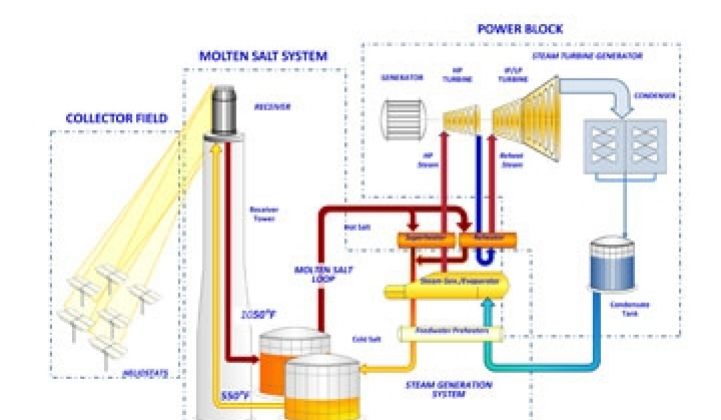SolarReserve says it can beat the competition by bringing salt one step closer to the sun.
The Santa Monica, Calif.-based company has created a solar thermal technology that uses heliostats -- relatively flat, independently mounted mirrors -- to focus the sun's heat on a large tank atop a 653-foot tower.
But unlike the heliostat power plants designed by BrightSource Energy and e-Solar, SolarReserve's tank isn't filled with water. Instead, the system relies on a mix of molten sodium and potassium salts heated to 1,050 degrees Fahrenheit (565 Celsius) to transfer heat from the heliostats to the power production unit at the plant.
Swapping out water for salt as a heat transfer fluid, SolarReserve argues, will allow it to match or top the output of the BrightSource Energy's Ivanpah plant and/or to increase the predictability of power production. Yesterday, the Nevada Public Utilities Commission approved a 100 megawatt plant near Tonopah.
But like a lot of things in the world of solar thermal, it's a big if. Solar thermal plants can produce baseline-quality power less expensively than conventional solar panels, but the immense size of solar thermal plants (most proposed commercial plants measure a few hundred megawatts), combined with fact that they often must sit near environmentally sensitive tracts of land, make them regulatory high-wire acts.
The technologies used in this approach -- parabolic mirrors, aluminum reflectors, towers, Stirling engines, molten calcium -- vary widely, too. As a result, traditional parabolic systems still dominate the market.
Then there are financial considerations. BrightSource has obtained $1.45 billion of Energy Department loan guarantees in July and will work with Bechtel to build the Ivanpah plant. Ausra got bought recently by Areva, the power giant owned largely by the French government.
SolarReserve has landed agreements to provide PG&E with 150 megawatts of power and NV Energy with 100 megawatts of power, and in 2008, the company raised $140 million. But as yet, it has neither a federal loan guarantee nor a big brother to oversee the project in order to keep banks and regulators calm. It is a wait-and-see situation.
The secret sauce boils down to the difference between salt and water. In a nutshell, salt dissipates heat at a slower rate. Imagine that a cloud passes over. In a system that relies on circulating water, the passing cloud will result in a reduction in the amount of heat that can be collected. Droplets can also form in the steam that circulates through the turbine, potentially causing corrosion over time.
The Department of Energy experienced some of these problems with the Solar One demo plant that was in operation in California in the 1980s.
"After a while, the plant operators became nervous about even small summer evaporation clouds. They found themselves running out of the control room, out onto the turbine deck to look up at the sky to see which clouds were approaching so they could scram the unit," wrote Bill Gould, Chief Technical Officer, in an e-mail. "When clouds cause this temperature drop, the first thing an operator does is drop the turbine output to the lowest level that still lets the plant stay connected to the grid."
In some ways, the technology is similar to the method that Tyco, Abengoa and Enel are using to replace therminol, the heat-carrying fluid in most parabolic trough systems, with molten salt to improve efficiency. The parabolic systems rely on a tube, instead of a tank, filled with a liquid, but the physics are the same.
Some of the concerns pointed out by SolarReserve have been countered by the industry. Companies that use water as a heat transfer fluid also generally put a natural gas boiler on the premises to guard against inclement weather.
The weather also remains surprisingly good, with some areas that are amenable to solar thermal plants enjoying 320 days or more of uninterrupted sun a year, according to Fred Morse, one of the world's experts on thermal.
The two-decades-old solar thermal plants in California's Mojave Desert "have not missed one hour of peak output in their lifetime," Morse told us last year. "When Mt. Pinatubo blew ash into the sky, they just burned a little more gas."
Working with molten salts is no picnic, either. Tyco execs have said that clumps can form, impeding performance. To this end, Tyco wraps the pipes in heating units. Corrosion has to be countered.
Pumping salt up and down a tall tower also increases the energy required to operate the plant. (In Abu Dhabi, Masdar Institute researchers are tinkering with a prototype that doesn't require pumping liquids into the sky.)
"Yes, salt is more dense and the receiver pump draws more power to pump salt than it would to pump water, but this auxiliary load is minimal as a percentage of total plant aux load," writes Gould.
And while employing salt as a transfer fluid makes it easier to add a molten salt heat storage unit -- you're essentially just adding a vat -- storage may be cost-ineffective right now. BrightSource, for instance, will not include a molten salt storage unit at Ivanpah. Why? California's power consumption rises abruptly in the morning and peak power drops off rapidly at night, said a BrightSource spokesperson. In states like Nevada, where peak power creates a more sloping bell curve because of lingering air conditioning consumption, storage makes more sense.
SolarReserve's technology comes from United Technologies' Pratt & Whitney RocketDyne. It was developed and tested at Solar Two in the California desert during the 1990s.



